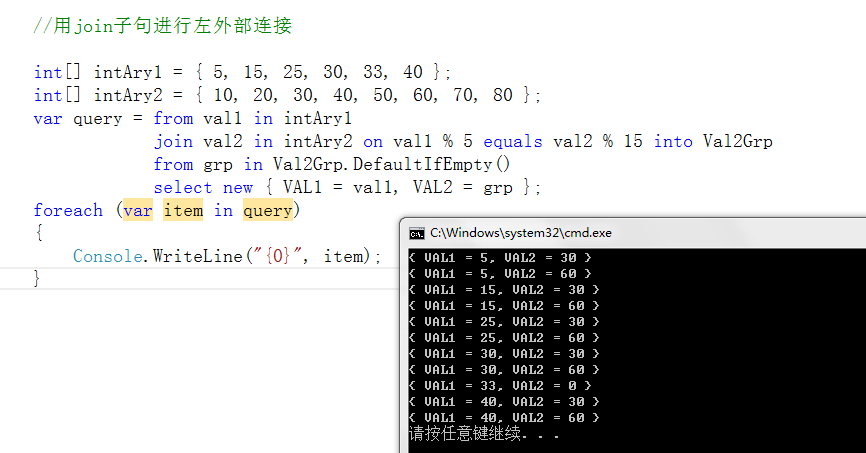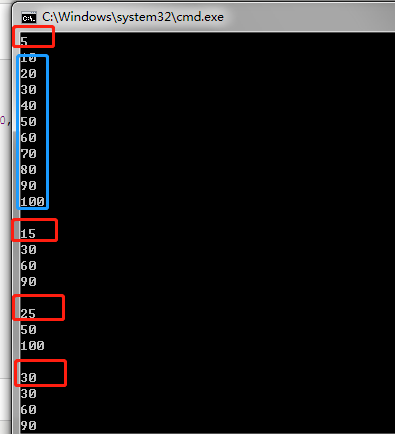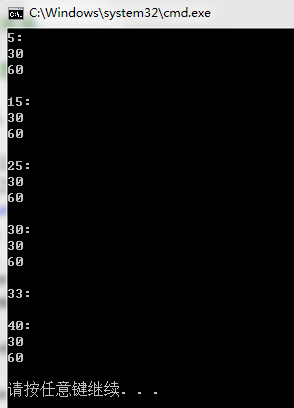Student[] stAry ={ new Student("张三","男",20), new Student("李四","男",21), new Student("王五","男",22), new Student("王妈妈","女",20), new Student("王丹","男",20), new Student("王真","女",20), };
数据源 stAry
1、返回数据源中所有元素
var query = from varl in stAry select varl; foreach (var item in query) { Console.Write("{0}", item); }
2.返回数据源中的姓名
var query = from varl in stAry select varl.Name; foreach (string item in query) { Console.Write("{0}", item); }
3、返回姓名的长度
var query2 = from varl in stAry select varl.Name.Length; foreach (var item in query2) { Console.Write("{0}", item); }
4、查询返回姓名,年龄,姓名长度
var query3 = from varl in stAry select new { varl.Name, varl.Age, varl.Name.Length }; foreach (var item in query3) { Console.Write(item); }
5、使用 where 指定筛选条件 和 order by 子句进行排序
int[] ary = { 11, 32, 10, 23, 54, 17, 19 }; var query = from varl in ary where varl > 15 orderby varl select varl; //这里默认是升序ascending,降序是descending
6、使用group by 子句进行分组
var query9 = from varl in stAry where (varl.Name.StartsWith("王")) group varl by varl.XingBie; //varl.Name.StartsWith("王") 是Linq里面的模糊查询 =》like ("王%")
7、用from子句进行复合查询
Student[] stAry ={ new Student("张三","男",20,new List<LessonScore>{new LessonScore("英语",80.5f),new LessonScore("语文",74.5f),new LessonScore("数学",60.5f)}), new Student("李四","男",21,new List<LessonScore>{new LessonScore("英语",60.5f),new LessonScore("语文",75.5f),new LessonScore("数学",80.5f)}), new Student("王五","男",22,new List<LessonScore>{new LessonScore("英语",40.5f),new LessonScore("语文",76.5f),new LessonScore("数学",15.5f)}), new Student("王妈妈","女",20,new List<LessonScore>{new LessonScore("英语",55.5f),new LessonScore("语文",780.5f),new LessonScore("数学",45.5f)}), new Student("王丹","男",20,new List<LessonScore>{new LessonScore("英语",87.5f),new LessonScore("语文",79.5f),new LessonScore("数学",66.5f)}), new Student("王真","女",20,new List<LessonScore>{new LessonScore("英语",99.5f),new LessonScore("语文",86.5f),new LessonScore("数学",36.5f)}), }; //用from子句进行复合查询 var query = from varl in stAry from j in varl.Scores where j.Score > 80 group new { varl.Name, j } by varl.Name; //group by 的语法是 group element by key ,其中element表示作为查询结果返回的元素,可以是一个也可以是多个,多个用new{a,b}写法,key表示分组条件 foreach (var item in query) { Console.WriteLine("{0}", item.Key);//外层先打印出名字 foreach (var j in item) { System.Console.WriteLine("{0}", j); } }
在上面这种形式的复合from字句中,内层的from子句并非一定要查询外层from子句中的元素的属性和方法,它可以是任何作为数据源的对象。
8、第二种from复合子句是在多个数据源上进行查询
//在多个数据源上进行的复合查询 int[] intAry1 = { 5, 15, 25, 30, 33, 50 }; int[] intAry2 = { 10, 20, 30, 40, 50, 60, 70, 80, 90, 100 }; var query = from st1 in intAry1 from st2 in intAry2 where st2 % st1 == 0 group st2 by st1; foreach (var item in query) { Console.WriteLine("{0}", item.Key); foreach (var item2 in item) { Console.WriteLine("{0}", item2); } Console.WriteLine(); }
//理论上可以写无数个from子句,但是会增加代码的复杂度,降低可读性和可维护性,建议不要超过三个
9、用Join子句进行连接
//用join子句进行连接查询 //1、内部连接 语法: join element in dataSource on exp1 equals exp2 int[] intAry1 = { 5, 15, 25, 30, 33, 40 }; int[] intAry2 = { 10, 20, 30, 40, 50, 60, 70, 80}; var query1 = from val1 in intAry1 join val2 in intAry2 on val1 % 5 equals val2 % 15 select new { VAL1 = val1, VAL2 = val2 }; foreach (var item in query1) { Console.WriteLine("{0}", item); }

item这里不能点key,因为select 后面接的是多个值
纠正:item这里不能点key, 是group之后才有key

输出的是VAL1%5和VAL2%5结果相等的,查询结果按第一个中的元素优先排列
用join子句进行分组连接
//用join子句进行分组连接 //语法: join element in dataSource on exp1 equals exp2 into grpName //grpName 是保存一组数据的集合 int[] intAry1 = { 5, 15, 25, 30, 33, 40 }; int[] intAry2 = { 10, 20, 30, 40, 50, 60, 70, 80 }; var query = from val1 in intAry1 join val2 in intAry2 on val1 % 5 equals val2 % 15 into val2Grp select new { VAL1 = val1, VAL2 = val2Grp }; foreach (var item in query) { Console.WriteLine("{0}:", item.VAL1); foreach (var item2 in item.VAL2) { Console.WriteLine("{0}", item2); } Console.WriteLine(); }
//val2Grp存储的是val2%15的结果
33这里为空,是因为intAry1中的元素即使在intAry2中不存在匹配元素也会产生一个空的列表
用join子句进行左外部连接

在LINQ中,通过对分组连接的结果调用DefaultIfEmpty()方法来执行外部连接。DefaultIfEmpty()方法从列表中获取置顶元素。如果列表为空则返回默认值。
左外部连接和分组连接相似但是并非一样。分组连接返回的查询结果是一种分层数据结构。需要两层foreach遍历结果。左外部连接是在分组连接的查询结果上再查询,所以在join后还有个from跟进查询。

